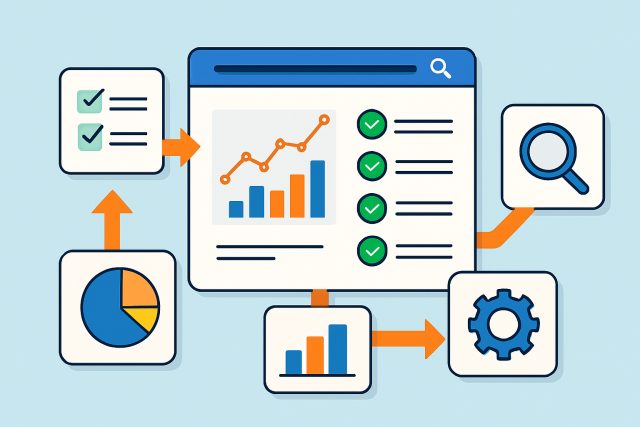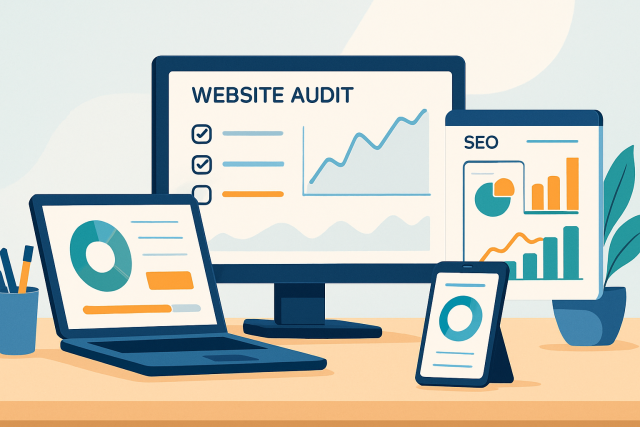How to Do a Website Audit for Better SEO Results?


A website audit is a thorough checkup of your site's overall health that focuses on the parts impacting search engine optimization. It’s important because search engines constantly tweak their algorithms and if your site doesn’t keep pace it can fall behind in the rankings. The main aim of an audit is to find technical hiccups, boost your content quality, assess the strength of your backlinks, and polish the user experience.
Getting Ready for Your Website Audit with Must-Have Tools and Metrics You Actually Need
Make sure you have got the right tools at your fingertips and pick the SEO metrics you will be keeping an eye on.
- Use Google Analytics to really get the lay of the land by observing user behavior and spotting traffic trends that might otherwise slip under the radar.
- Check Google Search Console for pesky crawl errors and indexing details that can make or break your SEO game.
- Run Screaming Frog SEO Spider to give your website a thorough once-over and unearth any sneaky technical issues.
- Dive into backlink profiles and domain authority with trusty tools like Ahrefs or Moz because they have saved me more than once from overlooking critical link data.
- Use Semrush for detailed audits and competitor research and to keep a close watch on keyword performance over time.
- Test site speed and user experience with PageSpeed Insights since slow and clunky don’t win races.
- Keep a sharp eye on mobile usability to ensure your site works well on every device since everyone’s browsing on the go these days.
- Regularly monitor keyword rankings to see how your SEO efforts are stacking up so you’re never flying blind.
Step 1 Reviewing Those Technical SEO Elements
Kick off your audit by diving deep into your website's technical setup—this is where the magic starts. Take a good look at site speed and crawlability. Also check indexation, secure connection, mobile responsiveness, XML sitemaps and robots.txt files.
Give tools like Google PageSpeed Insights a whirl to check your site speed and find any issues that might be slowing down load times.
Take a moment to ensure your robots.txt file isn’t accidentally blocking important pages from being crawled.
Have a peek at your sitemap.xml to confirm all your key pages are listed and easy for crawlers to reach.
Run Google’s Mobile-Friendly Test to see how smoothly your site performs on mobile devices because let’s face it mobile is where the party’s at.
Double-check that HTTPS is properly set up to keep connections secure and give SEO a boost.
Give Google Search Console a thorough once-over for any crawl errors broken links or pages missing from the index.

Example of a crawl report and mobile-friendliness test result highlighting technical SEO elements
Step 2 Take a Closer Look at Those Key On-Page SEO Elements
Take a close look at the key on-page SEO elements that move the needle for search rankings and how people interact with your site. This means diving into title tags, meta descriptions, URLs, header tags, keyword usage, content quality and internal links
- Make sure every page sports a unique and clear title tag that fits snugly within 50 to 60 characters.
- Whip up meta descriptions that not only inform but also engage, aiming for that sweet spot between 150 and 160 characters.
- Take a good look at your URLs to ensure they are clear and SEO-friendly, peppered with relevant keywords but steer clear of any unnecessary parameters that clutter things up.
- Double-check your header tags to make sure they follow a neat, logical order that helps organize your content like a pro.
- Keep an eye on keyword usage that flows naturally with the text, no over-the-top stuffing that sticks out like a sore thumb.
- Give your content a thorough once-over for relevance and originality, making sure it feels fresh enough to keep visitors coming back for more.
- Scan your internal links to guarantee they support smooth navigation and smartly spread page authority where it matters most.
Step 3 Take a Closer Look at Off-Page SEO and Your Backlink Profile
A solid backlink profile really signals to search engines that your site has some serious authority behind it. Doing a backlink audit is like giving your link profile a thorough checkup—it helps you spot those pesky harmful links that might be quietly dragging your rankings down. Plus, it’s a great way to take stock of the variety and quality of the sites linking to you.
- Keep an eye on the total number of backlinks and how they change over time. It’s like watching your little empire grow.
- Watch out for any spammy or harmful links that could get you penalized.
- Be sure to check the variety of anchor text. Having too much of the same can sound over-optimized, and we want to keep things natural.
- Take a close look at the domain authority and relevance of the sites linking to you because that signal matters a lot.
- Consider using tools like Semrush or Moz to disavow pesky low-quality links more efficiently. They have saved me a headache or two.
Step 4 Take a Good Hard Look at User Experience (UX) and See How Content Really Performs
When it comes to SEO success it really boils down to how visitors interact with your site. It’s worth taking a hard look at engagement metrics like bounce rate and session duration because these numbers tell the story. Check how intuitive your site navigation is and whether the content reads smoothly. Also observe how accessible everything feels.
- Take a good hard look at key metrics like bounce rate and average session duration using Google Analytics. These numbers can be surprisingly telling if you know where to focus.
- Give your site's navigation a fresh once-over to ensure menus are crystal clear and visitors can find what they’re after without frustrating detours.
- Take some time to review your content’s formatting. Think readability, headings, bullet points and adding multimedia to keep individuals genuinely engaged instead of just skimming.
- Double-check that your website meets all accessibility requirements so everyone can browse comfortably.
- Make sure all your call-to-action buttons and contact forms work flawlessly because nothing kills momentum like a broken link.
- Relying on technical mobile usability scores is not enough. Actually test your site on a variety of devices to get a real feel for the user experience because it’s worth the effort.
- Dive into heatmaps or session recordings to really get inside your users’ heads and uncover frustrating spots that might be tripping them up.
Step 5 Round Up Your Findings and Craft an SEO Action Plan That Actually Works
Arrange your audit results into clear actionable insights that make sense on paper. When prioritizing fixes, keep an eye on their potential impact and the effort required as well as any looming deadlines while setting timelines that won’t have you pulling all-nighters.
| SEO Issues | Description | Priority Level | Recommended Action | Estimated Time to Resolve |
|---|---|---|---|---|
| Slow Page Speed | Pages that take their sweet time to load can really drag down your rankings and frustrate visitors | High | Optimize images, leverage caching, and consider upgrading your hosting plan | 1-2 weeks |
| Broken Links | Links leading to those dreaded 404 errors can seriously tank your SEO credibility | Medium | Hunt down and fix or remove broken links | 3-5 days |
| Duplicate Meta Tags | Having copycat meta tags makes your pages less unique and can confuse search engines | Medium | Craft unique title tags and meta descriptions | 1 week |
| Toxic Backlinks | Harmful backlinks can sneakily sabotage your site's authority and search rankings | High | Disavow or get rid of harmful links as soon as possible | 2 weeks |
| Poor Mobile Usability | Clunky mobile navigation can quickly send your rankings downhill since mobile is king these days | High | Redesign with a responsive layout that feels smooth on any device | 2-3 weeks |
| Keyword Stuffing | Overloading your content with keywords tends to backfire by lowering rankings and turning off readers | Medium | Rewrite content to use keywords more naturally and sparingly | 1 week |
| Missing XML Sitemap | Without an XML sitemap, search engines might just overlook important pages on your site | High | Create and submit a sitemap pronto | 1-2 days |
Once you wrap up your SEO action plan, make a habit of keeping a close eye on your site’s performance and schedule regular audits—learning how to do a website audit properly means checking in every 3 to 6 months usually does the trick.

Sample SEO action plan dashboard illustrating task prioritization and progress tracking
Frequently Asked Questions
How often should I perform a website audit?
It is a smart move to run a thorough SEO audit every 3 to 6 months. This way you can catch new issues, adjust to algorithm updates and see how your past tweaks are holding up. Keeping an eye on metrics like keyword rankings and crawl errors monthly can also save you from unpleasant surprises.
Do I need to pay for expensive tools to do a proper audit?
Absolutely not. You can kick things off using solid free tools. Google Analytics and Google Search Console are your trusty sidekicks offering valuable insights into your traffic and technical health. For a more in-depth technical peek, the free version of Screaming Frog SEO Spider is handy. Tools like Ahrefs or Semrush pack more features but aren’t must-haves for getting the basics done right.
What should I put first first after finding numerous issues?
Start with the fixes that give you the biggest bang for your buck—that is the biggest impact compared to effort. Tackle critical technical problems first, especially those that block search engines like crawl errors or broken pages. Once those are out of the way, focus on on-page elements like title tags and content quality. Tackling high-impact, easy tasks early helps build momentum and nets quick SEO wins.
Is a website audit only for technical experts?
Not at all. While deep technical audits benefit from specialist knowledge, anyone can handle a basic audit by following a good guide and using the right tools. The process is straightforward: gather data with tools then review technical aspects, on-page elements and content. And if something stumps you, you can always call in an expert for help.
What is the biggest mistake people make during a website audit?
One common blunder is letting audit results gather dust without turning them into a clear actionable plan. An audit is only valuable if you act on its findings. Simply noting problems won’t cut it. You have to put first issues, assign tasks, set deadlines and track progress to improve your SEO efforts.
Unleash Your SEO Prowess with Semrush
Are you struggling to boost your online visibility and drive more traffic to your website? Semrush is the ultimate SEO and digital marketing tool that can take your Internet Marketing game to new heights. With its powerful suite of features, you can gain a comprehensive understanding of your market, optimize your content, and outrank your competitors.
- Uncover Profitable Keywords with Advanced Research
- Analyze Your Site's Health with Detailed Audits
- Monitor Backlinks and Stay Ahead of Competitors
- Streamline Content Creation with Insights and Trends








